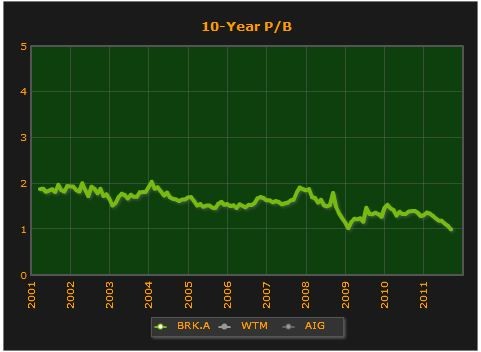Estimating Berkshire Hathaway s Intrinsic Value Again
Post on: 12 Июнь, 2015 No Comment

Estimating Berkshire Hathaway’s Intrinsic Value, Again
Originally posted on: May 25, 2005
Updated: May 26, 2005
Today, I am going to analyze Berkshire Hathaway. The company recently released its annual figures, so I figure that it’s time to re-examine its intrinsic value.
Let’s break up the company into three portions: insurance float, investments, and operating companies.
Insurance float: When customers pay premiums to an insurance company, it holds on to that money until it has to pay claims. In the mean time, it can invest this money (which is known as float) and earn interest on it. Usually, insurance companies take in less in premiums than they pay in claims; in other words, they operate at an underwriting loss. They make their profit from the interest on their float.
Now, assume that an insurance company runs a small underwriting loss. Then the total income of the company will be equal to its investment income minus that loss. So, the company’s total income will be less than its investment income. Therefore, the insurance float will be worth less than the cash it represents on the balance sheet.
If a company earns a low return on its investments, the float is also worth less than cash. Say an insurance company invests in low risk bonds, which yield 5%. If the company’s cost of float is zero, and if the company’s market value is equal to its investments, then the long-term return on the stock should be around 5%. Now, the company’s investment portfolio may be nearly risk-free, but the company itself probably isn’t. 5% may (or may not) be a reasonable return for low risk bonds, but it is a very poor return for an insurance stock. So this insurance company should trade at a discount to the value of its investments.
This can be offset by float growth. If an insurance company earns high returns on the cash it invests in its business, growth will generate value for shareholders. Suppose that:
1) An insurance company is expected to earn high returns on its insurance float
2) Its cost of float is around 3%
3) The company is growing at about 3% per year (which is about equal to inflation plus population growth).
Then the positive effect of growth should equally offset the negative effect of the underwriting loss.
Note that if the company earns low returns on its investments, its return on equity will probably be low, which means that growth will add no value to the company. In this case, growth would not offset the negative effect of the underwriting loss.
Berkshire’s insurance companies have earned an underwriting profit (on average). But Buffett expects the company to have slightly negative underwriting margins in the future. In my previous report on this company. I assumed that the cost of float would be 3%. My calculations, based on this number, suggested that the company’s float was worth less than the cash it represents. But 3% is a conservative number, considering that Berkshire has historically had a negative cost of float. It would be reasonable to value the float at its cash value. Geico’s float is an exception: its cost is negative and it is growing rapidly. I think it’s worth a lot more than the cash it represents.
In 2004, Berkshire’s total float was about $46 billion, and Geico represented roughly $6 billion of that.
Investments:
The company’s cash and investments totaled around $103 billion in 2004, 52 billion of which represents insurance float. The company had about $3.4 billion in debt, so the net value of its investments was around $100 billion. $37 billion of this was in equities, while the rest was in cash and bonds. I’m sure Buffett would like to have a lot more in equities, but over the past few years, he’s had had a hard time finding good buys.
Subsidiaries:
MidAmerican Energy:
Berkshire owns a 76% economic interest in this company. There earnings before taxes, excluding a write off related to a zinc project, was around $1.2 billion. If you add a tax rate of 35% (which is somewhat higher than their tax rate has recently been) and multiply this by 0.76, you get an earnings number of $593 million. Now, since MidAmerican is a regulated energy company, it can only earn a fair return on equity. This suggests that the company deserves a low price/earnings ratio. I would value it at 10-15 times earnings, depending on what discount rate I was using.
In my previous report on the company, I valued this investment its book value (3.8 billion). Obviously, this number is far too conservative.
Financial Products:
This segment covers a wide range of financial assets, including miscellaneous loans, venture capital operations, etc. I don’t know how to value this part of the business, but its net worth on the books is about $9.6 billion.
Other businesses:
Berkshire owns a lot of other companies, from candy companies to jewelry stores to building products. In 2004, pre-tax earnings for these businesses were $2481 million. If we add a 35% tax rate, we get $1612 million. You just have to come up with a reasonable earnings multiple, and then you’ll get a valuation. If you value them at 15 times earnings, the value of these businesses will be about 24 billion.
Now you just need to add the values of these three components. Here are some values I might give. These figures include a margin of safety, so they are somewhat conservative:
Cash and Investments at 90% of Fair Value    














